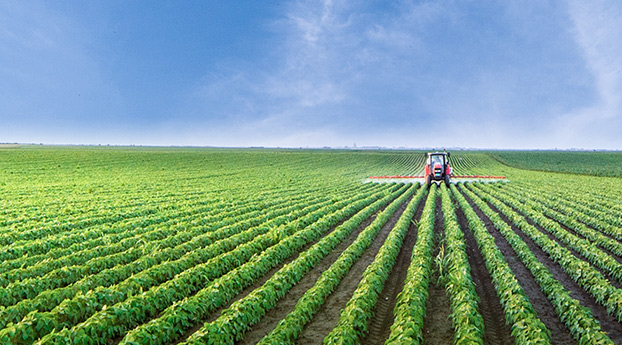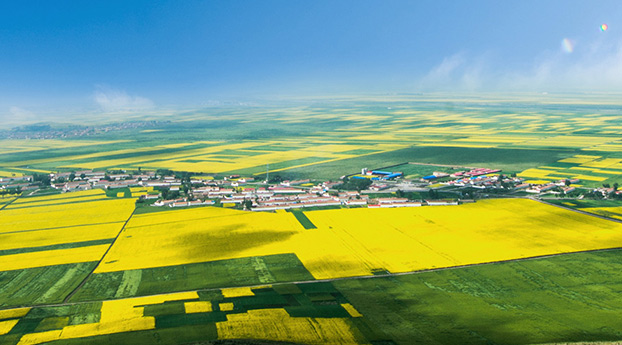Study on Water-saving and yield-increasing mechanism and optimal irrigation system of intercropping farmland in salinized area
Release time:2015-01-02 Views:78
【作者】 张作为;
【导师】 史海滨;
【作者基本信息】 内蒙古农业大学 , 农业水土工程, 2016, 博士
【摘要】 随着国家经济的不断发展,人口的不断增加,国家的粮食安全问题始终是影响国家安全稳定的基石,而间作种植模式由于具有提高光能利用率、改善通风透光条件、充分发挥边行优势等诸多优点,作为一项农业增产措施又被重新重视起来。河套灌区作为国家重要的商品粮储备基地,地处西北,光热资源丰富,是适宜间作种植模式的理想地点,然而由于河套灌区属于干旱半干旱下的盐渍化地区,且为保证黄河下游的经济发展,河套灌区面临指令性节水20\%的要求。因此,针对盐渍化地区间作模式下水分利用率低、盐分运移规律不明确、水分在两作物间的补偿作用还未定量化、高秆作物对矮秆作物遮阴影响程度不清楚、非充分灌溉下的根系系分布及吸水规律还未明确等问题,本文采用了根系分隔及分阶段控水等技术,开展了间作模式下地下部因素对间作优势及土壤盐分运移影响机理、高秆作物对矮秆作物遮荫影响、非充分灌溉下的水分利用效率、间作小麦小麦干物质转移与灌浆特征、间作作物根系分布特征及吸水规律、产量构成因子及水分敏感性等研究。本文的主要研究成果如下:1.河套灌区小麦/玉米间作系统的产量优势为27.67\%,其中20.44\%来源于地下部分的补偿作用,而7.23\%来自于地上部分。间作产量优势中的10.01\%产生于间作根系对土壤空间的叠加利用,而水分与养分在小麦带与玉米带间的补偿效应为10.43\%。小麦/向日葵间作系统的产量优势为33.33\%,其中28.17\%来源于地下部分的补偿作用,而5.16\%来自于地上部分。间作产量优势中的18.52\%产生于间作根系对土壤空间的叠加利用,而水分与养分在小麦带与向日葵带间的补偿效应为9.65\%。间作不会促使河套灌区盐碱地产生次生盐渍化的危险,反而具有轻微的控盐作用。2.研究表明,轻度分阶段控水不会对间作模式下的遮荫产生显著影响,间作模式下的遮荫影响不利于矮秆作物的生长和产量的形成。花后20天内由于高杆作物对矮秆作物的遮荫影响,致使间作小麦旗叶净光合速率、气孔导度与蒸腾速率分别降低了5.76\%-7.38\%、8.04\%-9.26\%、8.19\%-9.88\%,而胞间CO2浓度明显升高了5.20\%-5.22\%,造成间作小麦旗叶光合性能下降。但由于间作小麦冠层叶面积指数上升了18.09\%-19.97\%,及光能截获量的增加和底层叶片光合作用的增强,部分弥补了间作小麦群体光合作用的下降,使其降低幅度显著低于光合有效辐射的下降幅度。另外,由于边行效应的存在,使间作小麦群体在花前多存储了6.09\%-8.15\%的同化物,而花后虽然光合作用下降,但延缓了衰老,增加了光合作用时间,再加上花前同化物的大量转移,使间作下的小麦籽粒产量上升了3.05\%-6.10\%。3.小麦/玉米间作条件下作物根系混合程度主要经历“不混合-较大范围混合-大范围混合”三个过程。非充分灌溉小麦最大下扎深度较充分灌溉深10cm,根系最终平均分布深度较充分灌溉深8cm;非充分灌溉下的玉米最大横向伸展距离为30cm,充分灌溉则已超越边行小麦,最大下扎深度非充分灌溉较充分灌溉深15cm,根系最终平均分布深度较充分灌溉深12.1cm。根质量密度呈现“随离作物行距离增加而减小”的规律。非充分灌溉使间作小麦0-30cm土层中的根质量密度下降了12\%,使间作玉米0-30cm土层中的根质量密度下降了13\%。非充分灌溉边行小麦与边行玉米之间土壤含水率均值较充分灌溉提前5天左右下降到边行小麦与边行玉米土壤含水率均值之间。整个取样期内间作作物条带土壤含水率均值变化表现为:条带间>小麦条带>玉米条带。4.间作向日葵模式下的小麦茎、叶干物质转移量是相同灌水处理下间作玉米模式下的小麦茎、叶干物质转移量的1.08~1.86倍与1.12~2.17倍,而颖轴干物质转移量则间作玉米模式是间作向日葵模式的1.00~1.19倍,间作玉米模式下的小麦灌浆速率峰值出现在花后25-30d,较对照提前1.26-2.85d,而间作向日葵模式下的小麦灌浆速率峰值较对照提前1.8-2.44d,各处理最大灌浆速率与平均灌浆速率均较对照提高,且减少了达到最大灌浆速率所需时间。灌水总量较少(298mm-328mm)有利于延长间作玉米模式下小麦的活跃灌浆期,而较高灌水量(358mm-388mm)则会延长间作向日葵种植模式下小麦的活跃灌浆期。5.间作下的小麦分蘖期每多灌15mm有效分蘖数提高5.4\%-15.07\%,而乳熟期随着水分胁迫的加剧间作模式下的小麦穗粒数、千粒重、产量均呈现出先升高后降低的规律。适当的减少小麦分蘖与拔节期的灌水量,相应增加小麦乳熟与玉米灌浆吐丝期的灌水量,有利于大幅提高缺水地区间作模式下的玉米产量,且随着灌水总量的升高,穗粒数以1.27粒/mm-2.47粒/mm的速度递增,产量以62.24kg/mm,94.93kg/mm, 29.73kg/mm的“S”型速率曲线逐渐升高。随灌水总量的提高间作向日葵的单株粒数呈先升后降的规律,百粒重和产量则呈“N”和“M”型规律变化。对于不同水分处理下各间作作物对水分的敏感指数表现为小麦的敏感指数最高,玉米次之,向日葵最低。间作小麦受水分胁迫后其收获指数普遍提高,间作玉米的收获指数随灌水总量上升而逐渐上升,而受水分胁迫处理的向日葵收获指数反而下降了。
【Abstract】 With the continuous development of national economic construction and increasing population, the grain security problem of nation always is a foundation stone that influences the national security and stability. The intercropping mode has many advantages that are increasing utilization rate of solar energy, improving the ventilation and transmittance condition and giving full play to the boundary line. As a measure for increasing agricultural output, it was thought highly of again. Hetao irrigation district is a important commodity grain reserve base of country. It locates in northwest and has plentiful solar heat resource, which makes it become the ideal place for intercropping mode. However, Hetao irrigation district belongs to the salinization of arid and semi-arid district. In order to guarantee the economic development of the lower reaches of Yellow river, the Hetao irrigation district would face the mandatory requirement of saving 20\% water. Therefore, There are so many problems in the salinity area with intercropping. The water use efficiency is low. The transport law of salt is not clear. The compensation effect of water between two crops has not been quantified. The shade impact of high stalk crops on dwarf crops is not clear. The root distribution and water absorption law with non-sufficient irrigation is not yet clear. Aiming at these problems, this paper adopted the technology of root separation and water control in stages. Study the intercropping advantages with influence of underground factors and the soil salt movement mechanism. The shade impact of high stalk crops on dwarf crops and the water use efficiency with non-sufficient irrigation were studied. This paper explored the dry matter transferring and filling characteristics of intercropping wheat. The characteristics of intercropping root distribution and water absorption law were also studied. Finally, it studied the yield components and the water sensitivity. The main results of this paper are as follows:1. The yield advantage of wheat-maize intercropping system in Hetao irrigation district is 27.67\%. The 20.44\% of them derived from compensation action of underground part. The 7.23\% of them derived from aboveground part. The 10.01\% of intercropping yield advantage resulted from superposition of soil space by intercropping root. And the compensation effect of water and nutrient between wheat belt and maize belt is 10.43\%. The yield advantage of wheat-sunflower intercropping system in Hetao irrigation district is 33.33\%. The 28.17\% of them derived from compensation action of underground part. The 5.16\%of them derived from aboveground part. The 18.52\% of intercropping yield advantage resulted from superposition of soil space by intercropping root. And the compensation effect of water and nutrient between wheat belt and sunflower belt is 9.65\%.The intercropping would not make the saline-alkali land produce secondary salinization in Hetao irrigation district. On the contrary, it could control the salinity slightly.2. The research showed that slight controlling water by stages dose not produce significant effect on shading under intercropping model, the shading effect of intercropping mode was bad for the growing and the formation of production of dwarf crop. Due to the shading effect of high crop after 0-20 days of flowering, flag leaf net photosynthetic rate of wheat decrease 5.76\%-7.38\%, the stomatal conductance of wheat decrease 8.04\%~9.26\%, and transpiration rate of wheat decrease 8.19\%-9.88\%. The intercellular CO2 concentration increase 5.20\%-5.22\%. The above factors led to the photosynthesis degradation of wheat flag leaf. But the leaf area index of intercropping wheat canopy increase18.09\%-19.97\%. The increase of light interception amount and the enhancement of photosynthesis of bottom leaf partly compensated the photosynthesis decrease of intercropping wheat. The decrease degree was lower than the decrease of PAR significantly. Moreover, the border effect made the intercropping wheat more store 6.09\%-8.15\% assimilate before flowering. Although the photosynthesis decreased after flowering, the border effect delayed senescence and increased the photosynthetic time. With the much translocation of assimilate before flowering, the grain yield of intercropping wheat increase 3.05\%-6.10\%.3. The degree of crop root mixture of wheat-maize intercropping mainly experienced three processes which was "non-mixture-larger extent mixture-largest extent mixture". The maximum depth of wheat root with deficit irrigation is 10cm deeper than the maximum depth of sufficient irrigation. The final average distribution depth of root is 8cm deeper than it. The maximum lateral spreading distance of maize with deficit irrigation is 30cm. The maximum lateral spreading distance of maize with sufficient irrigation has surpassed the border wheat. The maximum depth of root is 15 cm deeper than the maximum depth of sufficient irrigation. The final average distribution depth of root is 12.1cm deeper than sufficient irrigation. The root mass density showed the law that it would decrease with the increase of crop row distance. The deficit irrigation made the root mass density of intercropping wheat decrease by 12\% in 0-30cm soil layer. It also made the root mass density of intercropping maize decrease by 13\% in 0-30cm soil layer. The average soil water content between border wheat and border maize with deficit irrigation was 5 days earlier than the sufficient irrigation. The average soil water content change of intercrop belt in the whole sampling date was:between belt>wheat belt>maize belt.4. The dry matter translocation yield of wheat stem and leaf intercropped with sunflowers or intercropped with maize were 1.08-1.86 times and 1.12-2.17 times, respectively, under the same irrigation treatment. The dry matter translocation yield of glume and cob from the maize model was 1-1.19 times that of the sunflower model. The wheat, intercropped with maize, reached a peak grain fill rate after 25-30 d of flowering. It was 1.26-2.85 d faster than the control treatment. The wheat, intercropped with sunflowers, reached a peak grain fill rate was 1.8-2.44 d faster than the control treatment. The maximum grain fill rate of both treatments and the average grain fill rate were all higher than the control treatment. Furthermore, they reduced the time needed for maximum grain fill rate. The lower irrigation,298-328 mm, were found to be conducive to extend the active filling stage of the wheat which was intercropped with maize. The higher irrigation, 358-388 mm, was found to be conducive to extend the active filling stage of the wheat which was intercropped with sunflowers.5. The irrigation amount by more 15mm, the effective tiller number increased 5.4\%~15.07\% in wheat tillering stage with intercropping, and with the aggravation of the water stress, the grains per spike,1000-grain weight and yield showed that first increase and then decrease trend in wheat milk stage with intercropping. Decrease the irrigation amount properly in wheat tillering stage and jointing stage and increase the irrigation amount in wheat milk stage and maize grouting silking stage were beneficial to increase the maize yield sharply with intercropping in water-deficient district, with the increase of total irrigation amount, the grains per spike increasing by the speed of 1.27grain/mm-2.47grain/mm, and the yield in "S" rate curve increased gradually of 62.24kg/mm,94.9g3k/mm,29.73kg/mm. With the increase of total irrigation amount, the seed number of intercropping sunflower showed that first increase and then decrease trend, the change of 100-seed-weight and yield as shown in N-shape and M-shape curve. For the water sensitivity index of intercropping crops with different irrigation treatments, it showed that the water sensitivity index of wheat was highest. The water sensitivity index of sunflower was lowest and the maize was middle. The harvest index of intercropping wheat with water stress was increased generally. The harvest index of intercropping maize increased with the increase of total irrigation amount. But the harvest index of intercropping sunflower decreased with the water stress.
【关键词】 间作; 隔根; 遮荫; 灌浆特征; 根系分布特征;
【Key words】 Intercropping; Root separation; Shading; Water use efficiency; Filling characteristics; Root distribution characteristics;

















